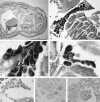A novel alpha-Proteobacterium resides in the mitochondria of ovarian cells of the tick Ixodes ricinus
- PMID: 15128508
- PMCID: PMC404433
- DOI: 10.1128/AEM.70.5.2596-2602.2004
A novel alpha-Proteobacterium resides in the mitochondria of ovarian cells of the tick Ixodes ricinus
Abstract
An intracellular bacterium from Ixodes ricinus ticks collected in Italy was characterized by electron microscopy (EM), PCR sequencing of the 16S rRNA gene, molecular phylogenetic analysis, and in situ hybridization (ISH). This bacterium was shown by EM to be present in the cytoplasm, as well as in the mitochondria of ovarian cells. When universal 16S rRNA bacterial primers were used, PCR amplification of ovarian DNA followed by cloning and sequencing resulted in the same sequence being found in each sample. Phylogenetic analysis of this sequence showed that the bacterium from which it was derived, tentatively designated IricES1, is part of a novel clade in the alpha subdivision of the Proteobacterium: ISH and PCR assays of various tissues performed with oligonucleotides specific for the IricES1 16S rRNA showed that IricES1 is restricted to ovarian cells. Based on the results obtained, we inferred that the bacteria seen by EM in ovarian cells are a single type of bacteria, corresponding to IricES1. PCR screening of 166 ticks from various parts of Italy and one site in England showed that IricES1 was present in 96% of adult females and 44% of nymphs (unsexed). No adult males were found to be infected. Despite the apparent parasitism of host mitochondria by IricES1, the available information suggests that the bacterium has an obligate relationship with its host, although this must be confirmed.
Figures



Similar articles
-
Widespread distribution and high prevalence of an alpha-proteobacterial symbiont in the tick Ixodes ricinus.Environ Microbiol. 2006 Jul;8(7):1280-7. doi: 10.1111/j.1462-2920.2006.01024.x. Environ Microbiol. 2006. PMID: 16817936
-
'Candidatus Midichloria mitochondrii', an endosymbiont of the tick Ixodes ricinus with a unique intramitochondrial lifestyle.Int J Syst Evol Microbiol. 2006 Nov;56(Pt 11):2535-2540. doi: 10.1099/ijs.0.64386-0. Int J Syst Evol Microbiol. 2006. PMID: 17082386
-
A symbiont of the tick Ixodes ricinus invades and consumes mitochondria in a mode similar to that of the parasitic bacterium Bdellovibrio bacteriovorus.Tissue Cell. 2004 Feb;36(1):43-53. doi: 10.1016/j.tice.2003.08.004. Tissue Cell. 2004. PMID: 14729452
-
[Emerging rickettsioses].Parassitologia. 2004 Jun;46(1-2):123-6. Parassitologia. 2004. PMID: 15305700 Review. Italian.
-
Symbiotic bacteria in oocyte and ovarian cell mitochondria of the tick Ixodes ricinus: biology and phylogenetic position.Parasitol Res. 2007 Apr;100(5):917-20. doi: 10.1007/s00436-006-0412-8. Epub 2007 Jan 17. Parasitol Res. 2007. PMID: 17226040 Review.
Cited by
-
Absence of zoonotic Bartonella species in questing ticks: first detection of Bartonella clarridgeiae and Rickettsia felis in cat fleas in the Netherlands.Parasit Vectors. 2011 Apr 18;4:61. doi: 10.1186/1756-3305-4-61. Parasit Vectors. 2011. PMID: 21501464 Free PMC article.
-
"Candidatus Midichloria" endosymbionts bloom after the blood meal of the host, the hard tick Ixodes ricinus.Appl Environ Microbiol. 2008 Oct;74(19):6138-40. doi: 10.1128/AEM.00248-08. Epub 2008 Aug 8. Appl Environ Microbiol. 2008. PMID: 18689508 Free PMC article.
-
Multi-country investigation of the diversity and associated microorganisms isolated from tick species from domestic animals, wildlife and vegetation in selected african countries.Exp Appl Acarol. 2021 Mar;83(3):427-448. doi: 10.1007/s10493-021-00598-3. Epub 2021 Mar 1. Exp Appl Acarol. 2021. PMID: 33646482 Free PMC article.
-
Analysis of the Microbial Community Structure of Ixodes persulcatus at Each Developmental Stage.Animals (Basel). 2025 Mar 13;15(6):830. doi: 10.3390/ani15060830. Animals (Basel). 2025. PMID: 40150359 Free PMC article.
-
A House for Two--Double Bacterial Infection in Euplotes woodruffi Sq1 (Ciliophora, Euplotia) Sampled in Southeastern Brazil.Microb Ecol. 2016 Feb;71(2):505-17. doi: 10.1007/s00248-015-0668-6. Epub 2015 Sep 17. Microb Ecol. 2016. PMID: 26381539
References
-
- Baumann, P., N. A. Moran, and L. Baumann. 1997. The evolution and genetics of aphid endosymbionts. Bioscience 47:12-20.
-
- Brinton, L. P., and J. H. Oliver, Jr. 1971. Fine structure of oogonial and oocyte development in Dermacentor andersoni Stiles (Acari: Ixodidae). J. Parasitol. 57:720-747. - PubMed
Publication types
MeSH terms
Substances
Associated data
- Actions
LinkOut - more resources
Full Text Sources
Other Literature Sources
Molecular Biology Databases

